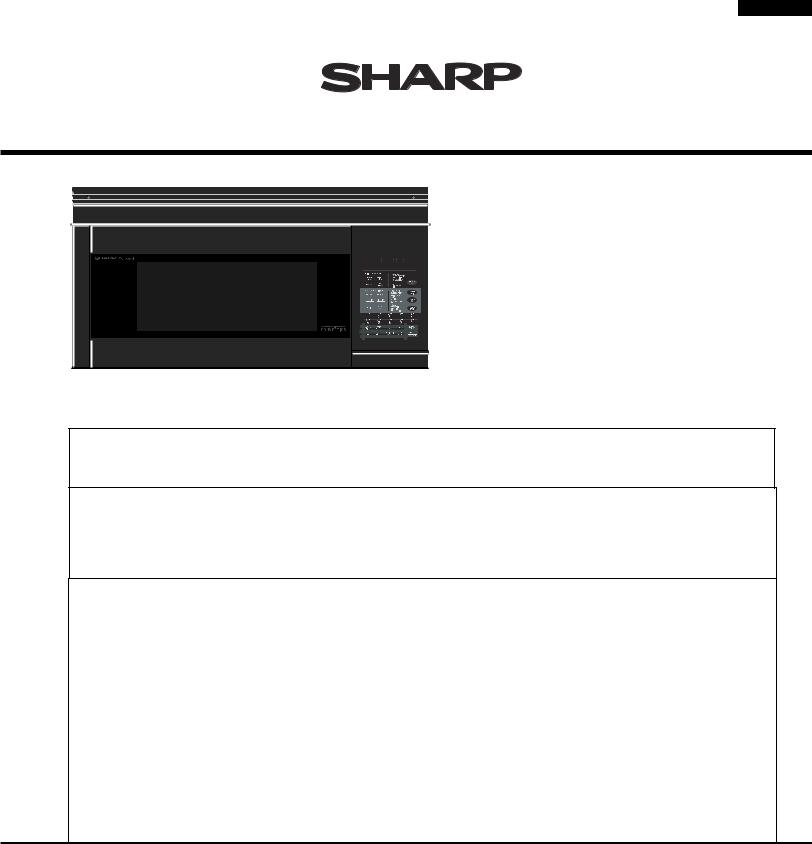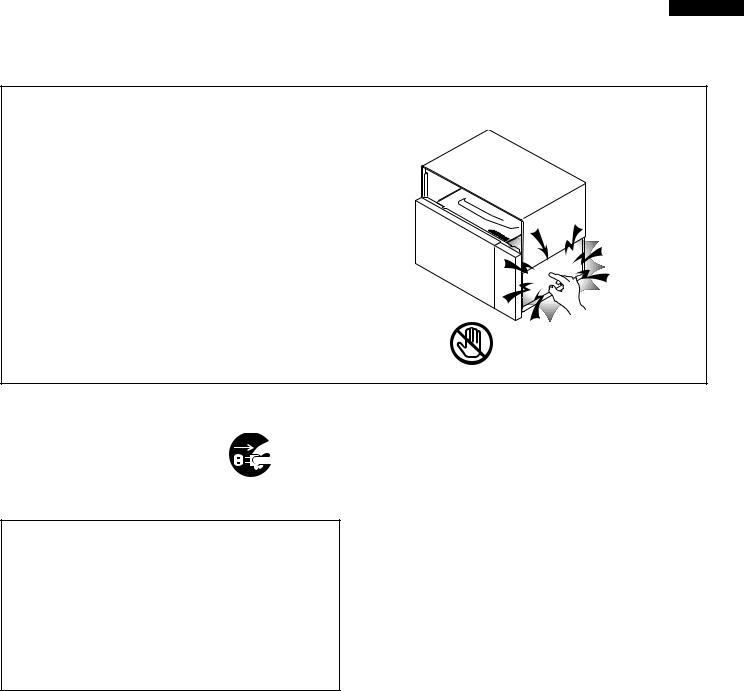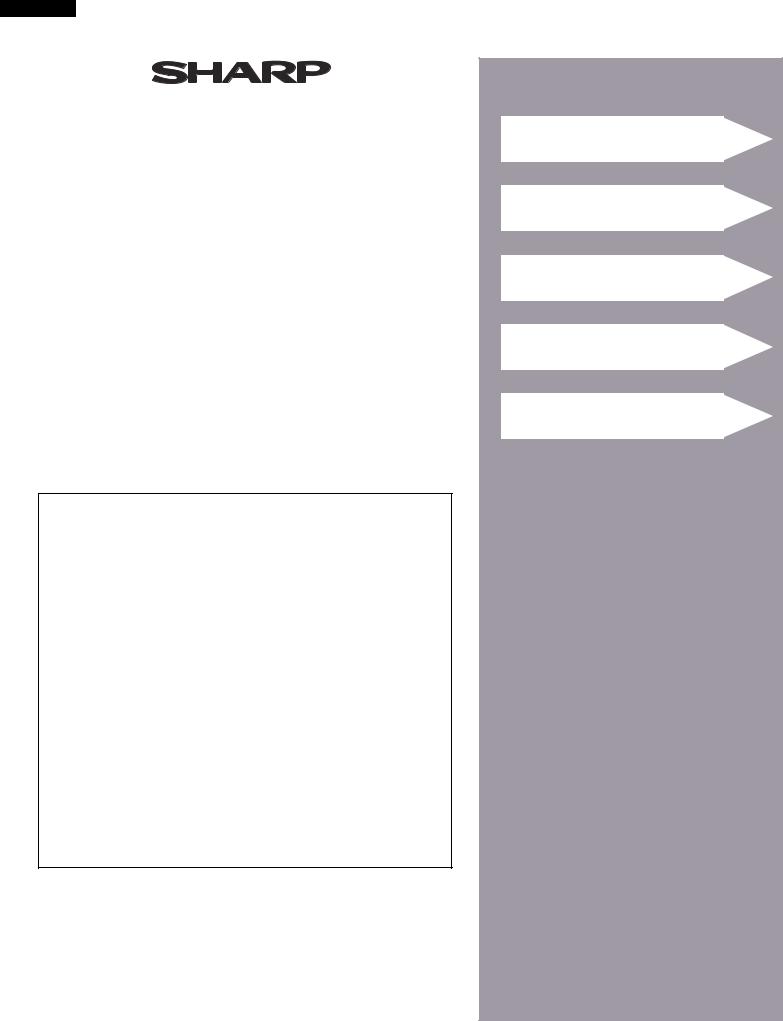SHARP R1874 Service Manual

R-1874
SUPPLEMENTAL SERVICE MANUAL
S52M187R1874E
MIX CONV
DEFROST
SENSOR
TURNTABLE ON OFF COOK LBS OZ KG HELP
OVER THE RANGE
MICROWAVE OVEN
MODEL R-1874
This is a supplemental Service Manual for Model R-1874.
This model is quite similar to Base Model R-1855A (S/M# S01M177R1875E).
Use this supplemental manual together with the Base Model Service Manual for complete operation and service information
In the interest of user-safety, the oven should be restored to its original condition and only parts identical to those specified should be used.
WARNING TO SERVICE PERSONNEL: Microwave ovens contain circuitry capable of producing very high voltage and current, contact with following parts may result in a severe, possibly fatal, electrical shock. (High Voltage Capacitor, High Voltage Power Transformer, Magnetron, High Voltage Rectifier Assembly, High Voltage Harness etc..)
TABLE OF CONTENTS
|
Page |
PRECAUTIONS TO BE OBSERVED BEFORE AND DURING SERVICE TO |
|
AVOID POSSIBLE EXPOSURE TO EXCESSIVE MICROWAVE ENERGY ................... |
INSIDE FRONT COVER |
BEFORE SERVICING ...................................................................................................... |
INSIDE FRONT COVER |
MICROWAVE MEASUREMENT PROCEDURE ..................................................................................................... |
1 |
WARNING TO SERVICE PERSONNEL.......................................................................................................... |
3 |
FOREWORD .......................................................................................................................................................... |
4 |
PRODUCT SPECIFICATIONS ............................................................................................................................... |
5 |
GENERAL INFORMATION ................................................................................................................................... |
5 |
PICTORIAL DIAGRAM .......................................................................................................................................... |
7 |
CONTROL PANEL CIRCUIT .................................................................................................................................. |
8 |
PARTS LIST .......................................................................................................................................................... |
9 |
PACKING AND ACCESSORIES ......................................................................................................................... |
15 |
This document has been published to be used for after sales service only. The contents are subject to change without notice.
(IN USA): |
SHARP ELECTRONICS CORPORATION |
|
Service Headquarters: Sharp Plaza, Mahwah, New Jersey, 07430-2135 |
|
OR: |
(INCANADA): |
SHARP CORPORATION |
|
SHARP ELECTRONICS OF CANADA LTD. |
Head Office: 335 Britannia Road East, Mississauga, Ontario L4Z 1W9 (905) 890-2100

R-1874
PRECAUTIONS TO BE OBSERVED BEFORE AND DURING SERVICING TO AVOID POSSIBLE EXPOSURE TO EXCESSIVE MICROWAVE ENERGY
(a)Do not operate or allow the oven to be operated with the door open.
(b)Make the following safety checks on all ovens to be serviced before activating the magnetron or other microwave source, and make repairs as necessary: (1) interlock operation (2) proper door closing, (3) seal and sealing surfaces (arcing, wear, and other damage), (4) damage to or loosening of hinges and latches, (5) evidence of dropping or abuse.
(c)Before turning on microwave power for any service test or inspection within the microwave generating compartments, check the magnetron, wave guide or transmission line, and cavity for proper alignment, integrity, and connections.
(d)Any defective or misadjusted components in the interlock, monitor, door seal, and microwave generation and transmission systems shall be repaired, replaced, or adjusted by procedures described in this manual before the oven is released to the owner.
(e)A microwave leakage check to verify compliance with the Federal Performance Standard should be performed on each oven prior to release to the owner.
BEFORE SERVICING (USA)
Before servicing an operative unit, perform a microwave emission check as per the Microwave Measurement Procedure outlined in this service manual.
If microwave emissions level is in excess of the specified limit, contact SHARP ELECTRONICS CORPORATION immediately @1-800-237-4277.
If the unit operates with the door open, service person should 1) tell the user not to operate the oven and 2) contact SHARP ELECTRONICS CORPORATION and Food and Drug Administration's Center for Devices and Radiological Health immediately.
Service personnel should inform SHARP ELECTRONICS CORPORATION of any certified unit found with emissions in excess of 4mW/cm2. The owner of the unit should be instructed not to use the unit until the oven has been brought into compliance.
BEFORE SERVICING (CANADA)
Before servicing an operative unit, perform a microwave emission check as per the Microwave Measurement Procedure outlined in this service manual.
If microwave emissions level is in excess of the specified limit, contact SHARP ELECTRONICS OF CANADA LTD. immediately.
If the unit operates with the door open, service person should 1) tell the user not to operate the oven and 2) contact SHARP ELECTRONICS OF CANADA LTD. and NHW, CANADA immediately.
Service personnel should inform SHARP ELECTRONICS OF CANADA LTD. of any certified unit found with emissions in excess of 4mW/cm2. The owner of the unit should be instructed not to use the unit until the oven has been brought into compliance.

R-1874
MICROWAVE MEASUREMENT PROCEDURE (USA)
A. Requirements:
1)Microwave leakage limit (Power density limit): The power density of microwave radiation emitted by a microwave oven should not exceed 1mW/cm2 at any point 5cm or more from the external surface of the oven, measured prior to acquisition by a purchaser, and thereafter (through the useful life of the oven), 5 mW/cm2 at any point 5cm or more from the external surface of the oven.
2)Safety interlock switches: Primary interlock relay and door sensing switch shall prevent microwave radiation emission in excess of the requirement as above mentioned, secondary interlock switch shall prevent microwave radiation emission in excess of 5 mW/cm2 at any point 5cm or more from the external surface of the oven.
B. Preparation for testing:
Before beginning the actual measurement of leakage, proceed as follows:
1)Make sure that the actual instrument is operating normally as specified in its instruction booklet.
Important:
Survey instruments that comply with the requirement for instrumentation as prescribed by the performance standard for microwave ovens, 21 CFR 1030.10(c)(3)(i), must be used for testing.
2)Place the oven tray in the oven cavity.
3)Place the load of 275±15 ml (9.8 oz) of tap water initially at 20±5½C (68½F) in the center of the oven cavity.
The water container shall be a low form of 600 ml (20 oz) beaker with an inside diameter of approx. 8.5 cm (3-1/2 in.) and made of an electrically nonconductive material such as glass or plastic.
The placing of this standard load in the oven is important not only to protect the oven, but also to insure that any leakage is measured accurately.
4)Set the cooking control on Full Power Cooking Mode
5)Close the door and select a cook cycle of several minutes. If the water begins to boil before the survey is completed, replace it with 275 ml of cool water.
C. Leakage test:
Closed-door leakage test (microwave measurement)
1)Grasp the probe of the survey instrument and hold it perpendicular to the gap between the door and the body of the oven.
2)Move the probe slowly, not faster than 1 in./sec. (2.5 cm/sec.) along the gap, watching for the maximum indication on the meter.
3)Check for leakage at the door screen, sheet metal seams and other accessible positions where the continuity of the metal has been breached (eg., around the switches, indicator, and vents).
While testing for leakage around the door pull the door away from the front of the oven as far as is permitted by the closed latch assembly.
4)Measure carefully at the point of highest leakage and make sure that the highest leakage is no greater than 4mW/cm2, and that the secondary interlock switch does turn the oven OFF before any door movement.
NOTE: After servicing, record data on service invoice and microwave leakage report.
1

R-1874
MICROWAVE MEASUREMENT PROCEDURE (CANADA)
After adjustment of the door switches are completed individually or collectively, switch test and microwave leakage test must be performed with survey instrument and test result must be confirmed to meet the requirement of the performance standard for microwave ovens as undermentioned.
A. Requirements:
Every microwave oven shall function in such a manner that when the oven is fully assembled and operating with its service controls and user controls adjusted to yield the maximum output, the leakage radiation, at all points at least 5 cm. from the external surface of the oven, does not exceed:
1)1.0mW/cm2 with the test load of 275 ± 15 ml of water at an initial temperature 20 ±5 oC.
2)5.0mW/cm2 when the outer enclosure is removed with a test load of 275 ± 15 ml of water at an initial temperature 20±5 oC.
3)5.0mW/cm2 without a test load.
B. Preparation for testing:
Before beginning the actual measurement of leakage, proceed as follows:
1)Make sure that the actual instrument is operating normally as specified in its instruction booklet. Important:
Survey instruments that comply with the requirement for instrumentation as prescribed by CSA and NHW performance standard for microwave ovens must be used for testing recommended instruments are , NARDA 8100 and NARDA 8200.
2)Place the oven tray in the oven cavity.
3)Place the load of 275±15 ml of tap water initially at 20±5 oC in the center of the oven cavity.
The water container shall be a low form of 600 ml beaker with an inside diameter of approx. 8.5 cm (3-1/2 in.) and made of an electrically nonconductive material such as glass or plastic.
The placing of this standard load in the oven is important not only to protect the oven, but also to insure that any leakage is measured accurately.
4)Set the cooking control on Full Power Cooking Mode, Close the door and select a cook cycle of several minutes. If the water begins to boil before the survey is completed, replace it with 275 ml of cool water.
C. Leakage test with enclosure installed :
1)Grasp the probe of the survey instrument and hold it perpendicular to the gap between the door and the body of the oven.
2)Move the probe slowly, not faster than 2.5 cm/sec. along the gap, watching for the maximum indication on the meter.
3)Check for leakage at the door screen, sheet metal seams and other accessible positions where the continuity of the metal has been breached (eg., around the switches, indicator, and vents).
While testing for leakage around the door pull the door away from the front of the oven as far as is permitted by the closed latch assembly.
4)Measure carefully at the point of highest leakage and make sure that the highest leakage is no greater than 4mW/cm2, and that the secondary interlock switch does turn the oven OFF before any door movement.
C. Leakage test without enclosure:
1)Remove the enclosure (cabinet).
2)Grasp the probe of the survey instrument and hold it perpendicular to all mechanical and electric parts of the oven that is accessible to the user of the oven including, but not limited to, the waveguide, cavity seams, magnetron gap between the door and the body of the oven.
3)Move the probe slowly, not faster than 2.5 cm/sec. along the gap, watching for the maximum indication on the meter.
4)Measure carefully at the point of highest leakage and make sure that the highest leakage is under 5mW/cm2.
CAUTION: Special attention should be given to avoid electrical shock because HIGH VOLTAGE is generated during this test
No Load test
1) Operate the oven without a load and measure the leakage by the same method as the above test procedure " Leakage test with enclosure installed"
2. Make sure that the highest leakage should not exceed 5mW/cm2.
NOTE: After servicing, record data on service invoice and microwave leakage report.
2

R-1874
WARNING TO SERVICE PERSONNEL
Microwave ovens contain circuitry capable of producing very high voltage and current, contact with following parts may result in a severe, possibly fatal, electricalshock.
(Example)
High Voltage Capacitor, High Voltage Power Transformer, Magnetron, High Voltage Rectifier Assembly, High Voltage Harness etc..
Read the Service Manual carefully and follow all
instructions.
Don't Touch ! Danger High Voltage
Before Servicing
1. Disconnect the power supply cord |
and then |
remove outer case. |
|
2.Open the door and block it open.
3.Discharge high voltage capacitor.
WARNING: RISK OF ELECTRIC SHOCK. DISCHARGE THE HIGH-VOLTAGE CAPACITOR BEFORE SERVICING.
The high-voltage capacitor remains charged about 60 seconds after the oven has been switched off. Wait for 60 seconds and then short-circuit the connection of the high-voltage capacitor (that is the connecting lead of the high-voltage rectifier) against the chassis with the use of an insulated screwdriver.
Whenever troubleshooting is performed the power supply must be disconnected. It may in, some cases, be necessary to connect the power supply after the outer case has been removed, in this event,
1.Disconnect the power supply cord, and then remove outer case.
2.Open the door and block it open.
3.Discharge high voltage capacitor.
4.Disconnect the leads to the primary of the power transformer.
5.Ensure that these leads remain isolated from other components and oven chassis by using insulation tape.
6.After that procedure, reconnect the power supply cord.
When the testing is completed,
1. Disconnect the power supply cord, and then remove
outer case.
2.Open the door and block it open.
3.Discharge high voltage capacitor.
4.Reconnect the leads to the primary of the power transformer.
5.Reinstall the outer case (cabinet).
6.Reconnect the power supply cord after the outer case is installed.
7.Run the oven and check all functions.
After repairing
1.Reconnect all leads removed from components during testing.
2.Reinstall the outer case (cabinet).
3.Reconnect the power supply cord after the outer case is installed.
4.Run the oven and check all functions.
Microwave ovens should not be run empty. To test for the presence of microwave energy within a cavity, place a cup of cold water on the oven turntable, close the door and set the power to HIGH and set the microwave timer for two (2) minutes. When the two minutes has elapsed (timer at zero) carefully check that the water is now hot. If the water remains cold carry out Before Servicing procedure and reexamine the connections to the component being tested.
When all service work is completed and the oven is fully assembled, the microwave power output should be checked and microwave leakage test should be carried out.
3

R-1874
SUPPLEMENTAL
SERVICE MANUAL
MICROWAVE OVEN
R-1874
FOREWORD
This Manual has been prepared to provide Sharp Electronics Corp. Service Personnel with Operation and Service Information for the SHARP MICROWAVE OVEN, R-1874.
The model R-1874 is quite similar to base model R-1855A (Ref.# S99M138R1855E)
It is recommended that service personnel carefully study the entire text of this manual and the base model's manual so that they will be qualified to render satisfactory customer service.
Check the interlock switches and the door seal carefully. Special attention should be given to avoid electrical shock and microwave radiation hazard.
WARNING
Never operate the oven until the following points are ensured:
(A)The door is tightly closed.
(B)The door brackets and hinges are not defective.
(C)The door packing is not damaged.
(D)The door is not deformed or warped.
(E)There is no other visible damage with the oven.
Servicing and repair work must be carried out only by trained service personnel.
DANGER
Certain initial parts are intentionally not grounded and present a risk of electrical shock only during servicing. Service personnel - Do not contact the following parts while the appliance is energized;
High Voltage Capacitor, Power Transformer, Magnetron, High Voltage Rectifier Assembly, High Voltage Harness;
If provided, Vent Hood, Fan assembly, Cooling Fan Motor.
All the parts marked “*” on parts list are used at voltages more than 250V.
Removal of the outer wrap gives access to voltage above 250V.
USA MODEL
SHARP ELECTRONICS CORPORATION
SHARP PLAZA, MAHWAH,
NEW JERSEY 07430-2135
CANADIAN MODEL
OSAKA, JAPAN
PRODUCT DESCRIPTION
GENERAL INFORMATION
OPERATION
WIRING DIAGRAM
PARTS LIST
4
